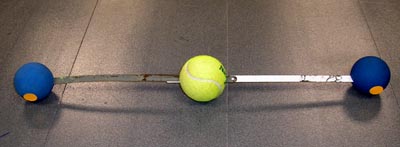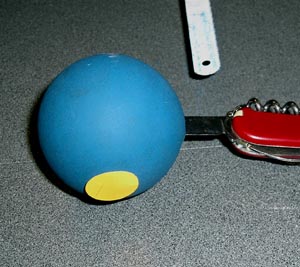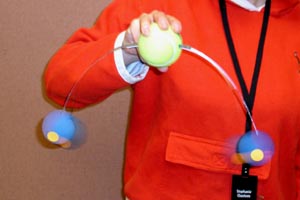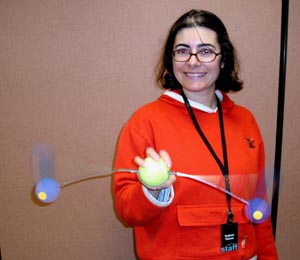
The carbon dioxide model
Carbon Dioxide Models
Introduction
Carbon dioxide is a greenhouse gas, it absorbs infrared radiation. Build two models to show how carbon dioxide, CO2, vibrates when it absorbs infrared radiation.
Model 1 The bending model
Material
Assembly
Use the pocket knife to cut one slit in each racquet ball just big enough to accept the hacksaw blade.

Cut a slit in the balls with a pocket knife.
Cut two slits in the tennis ball on exact opposite sides so that a hacksaw blade can be pushed all the way through.
Push one hacksaw blade through the tennis ball so that it stick out one side about an inch.
Push another hacksaw blade through the tennis ball in the opposite direction so that it also sticks out one inch on the other side of the tennis ball. Wrap tape around the two hacksaw blades where they overlap on opposite sides of the tennis ball.
Push the racquet balls onto each end of the hacksaw blades.
Push the racquet balls onto the hacksaw blades until they touch the inside of the racquet ball.
To Do and Notice
Notice that the central atom in the carbon dioxide molecule represented by the tennis ball is a carbon atom. The two outer atoms represented by the racquet balls are oxygen.
Notice that carbon dioxide is a linear molecule.
Hold the carbon dioxide model horizontally. Hold the tennis-ball-carbon in one hand.
Shake the tennis ball up and down gently, try to find the resonant frequency where the oxygen-racquet-balls move the most up and down for the smallest motion of the carbon dioxide.

At resonance the oxygens move a lot for a small motion driving the
oscilllation.
When the carbon dioxide model is vibrating it has vibrational energy, this energy came from your hand. When a carbon dioxide molecule interacts with infrared radiation at its resonant frequency it also absorbs energy from this radiation.
Stop vibrating the molecule. Notice that it continues to vibrate on its own.
Notice that the oxygens move up together relative to the carbon.
The oxygens have a negative charge the carbon has a positive charge. As they move relative to each other the accelerating positive and negative charges give off infrared radiation. The molecule then stops vibrating and is ready to absorb another photon of infrared radiation.
Now shake the carbon up and down again this time as fast as you can.

At high frequencies the oxygens move a little.
Notice that the oxygens hardly move.
This high frequency shaking represents visible light. Carbon dioxide is transparent in the visible portion of the spectrum.
Next shake the carbon up-and-down slowly perhaps once a second.
Notice that the oxygens barely move, this represents the response of this bending mode of the carbon dioxide to microwave radiation.
The carbon dioxide bending illustrated here absorbs infrared radiation, not visible or microwave radiation.
Model 2 The asymmetric linear oscillator model
Material
Assembly
Slide the donut magnets onto the pencil so that the central magnet is repelled by the two outer magnets.
Optional paint the outer and inner magnets different colors perhaps yellow for the central carbon and red for the two outer oxygens.
Optional slide on the middle magnet then wrap masking tape around the ends of the pencil to hold the outer magnets in place when they are slid onto the pencil.
To Do and Notice
Hold the pencil and the two outer oxygens in your hands, hold the pencil horizontally.
Move the pencil back and forth along its length and watch the central magnet move back and forth between the outer magnets.
Try to find the resonant frequency where the smallest motion of the pencil produces the maximum motion of the central magnet.
Explore moving the pencil at very high frequencies and very low frequencies.
Notice that this model also has a resonant frequency.
The carbon dioxide molecule has a resonant frequency of this oscillation in the infrared portion of the spectrum.
As the positive charge of the carbon moves back and forth it emits infrared radiation.
What's Going On?
These two resonances of the carbon dioxide molecule absorb infrared radiation and turn it into vibration of the molecule.
The molecule then either reradiates the infrared radiation or suffers a collision with another molecule and turns the vibration into thermal energy of translation.
The Atmospheric Greenhouse Effect
Visible light radiation from the sun passes right by the carbon dioxide molecules in the atmosphere, as well as the nitrogen, oxygen and argon. It then strikes the surface of the earth (Well some is scattered by the atmosphere or reflected by clouds but lets ignore that part for now.) The visible light strikes the ground where it is either reflected into space or absorbed by the ground and turned into thermal energy. That is it warms the ground.
The warm ground reemits radiation, but the ground is much cooler than the sun, Thank Goodness!, so the ground doesn't emit visible light it emits infrared radiation.
If this infrared radiation escaped into space then the departing energy would cause the earth to have an average temperature near freezing.
However, the infrared radiation is absorbed by carbon dioxide molecules bending and vibrating in resonance with the frequency of the infrared radiation.
The carbon dioxide molecules then reradiate the infrared radiation in a random direction.
Half the time the reradiated infrared is sent back down toward the ground.
So radiation that would have been lost to space is returned to the ground warming the ground.
Some of the infrared radiation absorbed by the carbon dioxide is converted by collisions between molecules into translational motion of the molecules and directly heats the atmosphere.
The result is that the temperature of the earth averages a pleasant 16 °C.
Some greenhouse warming of the earth is a good thing.
|
Scientific Explorations with Paul Doherty |
|
21 November 2006 |